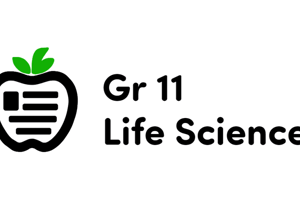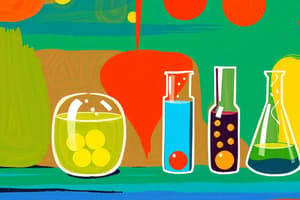Podcast
Questions and Answers
What flows between a system and its surroundings?
What flows between a system and its surroundings?
- Light
- Electricity
- Heat (correct)
- Sound
Which part of the universe is under study in thermodynamics?
Which part of the universe is under study in thermodynamics?
- Energy
- Universe
- System (correct)
- Surroundings
What is defined as the surroundings in thermodynamics?
What is defined as the surroundings in thermodynamics?
- System under study
- Everything outside the system (correct)
- Heat flow
- Energy storage
Which term in thermodynamics describes the part of the universe under consideration?
Which term in thermodynamics describes the part of the universe under consideration?
What specifically flows between a system and its surroundings?
What specifically flows between a system and its surroundings?
Which of the following best describes the intermolecular forces of a gas?
Which of the following best describes the intermolecular forces of a gas?
What is the relationship between pressure (P) and volume (V) according to the ideal gas equation?
What is the relationship between pressure (P) and volume (V) according to the ideal gas equation?
What does the gas constant 'R' represent in the ideal gas equation PV = nRT?
What does the gas constant 'R' represent in the ideal gas equation PV = nRT?
Which statement about intermolecular forces in gases is false?
Which statement about intermolecular forces in gases is false?
In the ideal gas equation, what does 'n' represent?
In the ideal gas equation, what does 'n' represent?
What is the ideal gas constant in the given text?
What is the ideal gas constant in the given text?
What is the value of the term '𝑉 (1.82)(0.082)(69.5 + 273)' in the given text?
What is the value of the term '𝑉 (1.82)(0.082)(69.5 + 273)' in the given text?
What is the unit of the ideal gas constant used in the calculation?
What is the unit of the ideal gas constant used in the calculation?
In the formula 𝑛𝑅𝑇 𝑃= 𝑉 (1.82)(0.082)(69.5 + 273), what does '𝑉' represent?
In the formula 𝑛𝑅𝑇 𝑃= 𝑉 (1.82)(0.082)(69.5 + 273), what does '𝑉' represent?
What does 'STP' stand for in the given text?
What does 'STP' stand for in the given text?
Which type of system allows the passage of mass, heat, and work?
Which type of system allows the passage of mass, heat, and work?
In a closed system, is the transfer of mass allowed?
In a closed system, is the transfer of mass allowed?
Which type of system allows the transfer of heat and work but not mass?
Which type of system allows the transfer of heat and work but not mass?
If a system allows the passage of mass but not heat or work, what type of system is it?
If a system allows the passage of mass but not heat or work, what type of system is it?
Which type of system restricts the transfer of both mass and heat?
Which type of system restricts the transfer of both mass and heat?
Which statement is true about the volume of a real gas compared to an ideal gas?
Which statement is true about the volume of a real gas compared to an ideal gas?
How does the pressure of a real gas compare to that of an ideal gas?
How does the pressure of a real gas compare to that of an ideal gas?
If the volume of an ideal gas is 4.5 L, what would you expect the volume of a real gas under similar conditions to be?
If the volume of an ideal gas is 4.5 L, what would you expect the volume of a real gas under similar conditions to be?
What effect does temperature have on the pressure exerted by a real gas compared to an ideal gas?
What effect does temperature have on the pressure exerted by a real gas compared to an ideal gas?
In a steel vessel containing 2 moles of an ideal gas at 300 K, how does the pressure compare to the pressure exerted by 2 moles of a real gas at the same temperature?
In a steel vessel containing 2 moles of an ideal gas at 300 K, how does the pressure compare to the pressure exerted by 2 moles of a real gas at the same temperature?
Flashcards are hidden until you start studying
Study Notes
Ideal Gas
- Ideal gas does not have intermolecular forces (attraction or repulsion) with other gas particles.
- Ideal gas equation: PV = nRT, where R is the gas constant.
Real Gas vs Ideal Gas
- Real gas has a larger volume (V real > V ideal) due to molecular interactions.
- Real gas has a lower pressure (P real < P ideal) due to molecular interactions.
Example Problems
- Example 1: Calculating pressure of sulfur hexafluoride (SF6) ideal gas in a steel vessel:
- Given: n = 1.82 moles, V = 5.43 L, T = 69.5°C
- Solution: P = nRT / V = (1.82)(0.082)(69.5 + 273) / 5.43 = 9.42 atm
- Example 2: Calculating volume occupied by CO2 at STP:
- Given: mass of CO2 = 7.40 g
- Solution: (not shown in the provided text)
Thermodynamic Terms
- System: The part of the universe under study.
- Open System: A system with a wall that allows the passage of mass, heat, and work.
- Closed System: A system that only allows the transfer of heat and work, not mass.
Studying That Suits You
Use AI to generate personalized quizzes and flashcards to suit your learning preferences.




